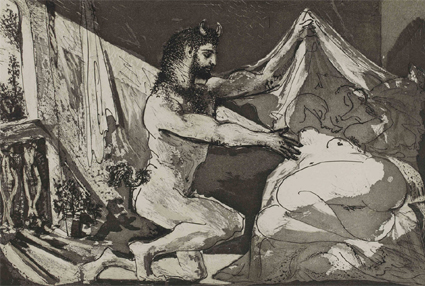Picasso Prints: The Vollard Suite” at the British Museum.
As well as being the most influential painter, sculptor and draughtsman of the twentieth-century, Picasso was one of the most fertile and inventive printmakers – never more so than during the 1930s, a decade of unprecedented personal and political upheaval. Early in 1933 he met the talented Parisian printer and engraver Roger Lacouriere, in whose workshop he would create many of his most memorable images. Jaime Sabartes, the artist’s personal secretary, wrote an eyewitness account of their collaboration: “While Lacouriere turned the crank of the rosin box, put the plate on the grill, applied it to the gas jet or bathed it in acid, and a worker made proofs of the engraving, Picasso would retouch the preceding one or begin to engrave a new one. At six the printers left. To please Picasso, Lacouriere would remain, and then precisely as if he were in his own studio and quite independent of anyone Picasso would begin the new experiments.”
The most remarkable of those experiments was the so-called Vollard Suite, a sequence of engravings commissioned from Picasso by the fabulously wealthy art dealer Ambroise Vollard. Brought to completion in 1937 after several years’ work, its hundred images form an elusive, confessionally intimate cartoon-strip in which the artist reflects obsessively both on his creativity and his sexuality. Intact sets are extremely rare, so much so that the Vollard Suite in its entirety has never been exhibited in this country – never, that is, until now. In spring 2011 a collector of modern prints named Hamish Parker generously gave the British Museum a complete, pristine copy; a year later, the full sequence has been placed on display in the galleries of the museum’s Department of Prints and Drawings.
Because these images were never given...


